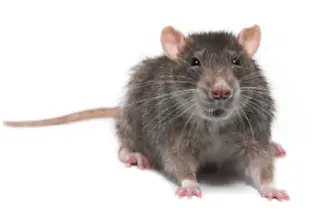The success of one of the most ambitious and contested federal science programs in years may rest on the delicate shoulders of a one-pound albino breed of rat known as Sprague Dawley. In a hotly debated move, the U.S. Environmental Protection Agency (EPA) has selected this unassuming rodent as the primary test animal for a vastly complex and comprehensive new chemical-evaluation program. The effort is designed to investigate many of the most vexing public-health questions of the day: Are you putting yourself, your children, or even your children’s children at risk when you microwave food in plastic containers? What is contributing to hormone-related killers like breast, uterine, and testicular cancer? And are common garden sprays—like the one you use to keep the aphids off your hybrid tea rose—affecting your unborn baby’s developing brain?
The EPA initiative, called the Endocrine Disruptor Screening Program, is set to begin testing some of the 87,000 chemicals identified by a federal advisory panel for their potential to interfere with the body’s endocrine, or hormone, system. As the body’s chemical messengers, hormones play a critical role in regulating biological processes including metabolism, reproduction, and brain development. The female ovaries, male testes, and pituitary, thyroid, and adrenal glands are all part of this complex system. Endocrine disruptors may mimic natural hormones or block their normal action, cause the body to produce too much or too little of a hormone, or scramble a hormone’s message so that the body thinks it should abort a fetus, for example, or produce extra insulin. If any of the thousands of chemicals in common use today adversely affect the human hormone system, the EPA’s testing program should catch them—but only if Sprague Dawley catches them first. And therein lies the controversy.
Since World War II, this white-furred rodent with beady red eyes has been among industry’s most often used lab rats for testing drugs and chemicals before they hit the market. The animal’s utility is undisputed; it has helped researchers study not just pharmacology and toxicology but everything from cancer and AIDS to obesity and aging. In this case, though, it may be the wrong rat for the job. Critics say that Sprague Dawley is a kind of superrodent whose hearty constitution may not react in ways an average human’s would. If so, the animal could give a clean bill of health to chemicals that actually pose a real threat to human well-being.
Last spring the EPA convened a scientific advisory panel to make final adjustments to the proposed testing program. One panelist was David Furlow, a University of California at Davis endocrinologist with extensive experience in rat-strain variations and how they can affect outcomes in the lab. He tried repeatedly to raise a red flag about Sprague Dawley. “I’ve known about these differences since I was an undergraduate in the 1980s,” Furlow says, citing scientific literature that suggests it is more resistant to endocrine-disrupting chemicals than other rat strains. His concerns, he says, were downplayed.
Sprague Dawley’s unique characteristics have been evident for decades. In 1946 physical chemist Robert Dawley’s company sent a letter to the National Institutes of Health (NIH) detailing how, through selective breeding, Dawley had developed a rat (Sprague was his first wife’s maiden name) with good temperament, vigor, and high rates of lactation. But Sprague Dawley’s good genes—not to mention its fecundity—could have bad consequences for humans: A prolific breeder may not be the best test subject for chemicals that may cause infertility and other reproductive problems. The letter to the NIH also stated that the rat strain had been bred for “high resistance to arsenic trioxide,” a toxic substance used in insecticides and herbicides and known today to be an endocrine disruptor.
“It’s a significant problem,” says Jef French, acting chief of the Host Susceptibility Branch of the National Toxicology Program at the National Institute of Environmental Health Sciences. (French emphasized that he was speaking for himself and not the government.) “Because of Sprague Dawley’s [genetic] selection, chemicals that might be harmful to humans might be judged to be nonharmful to the rat,” he says.
The results of the EPA’s tests could guide federal regulation of numerous chemicals for many years to come, so the stakes for both the public and the chemical industry are enormous.
The far-reaching Endocrine Disruptor Screening Program dates to 1996, when Congress ordered the EPA to begin testing chemicals for their potential to interfere with the human endocrine system. By some accounts the legislation was prompted by the publication earlier that year of a book titled Our Stolen Future. Called “an environmental thriller” by The Washington Post, the book, by two zoologists and an environmental journalist, called attention to a longtime concern of environmentalists: failing wildlife populations and strange deformities in the offspring of those that survived. For instance, there was a massive die-off of alligators after a 1980 pesticide spill in Florida’s Lake Apopka. Studies later found deformed sex organs in the offspring of the remaining gator population, even after tests showed the water in the lake to be apparently clean. Mink ranchers in the Great Lakes region who fed their animals local fish began noticing that the females weren’t producing pups, a problem later linked to PCB contamination. In California researchers found what came to be known in the press as “gay gulls”: same-sex seagull couples shacking up together in the nest, protecting eggs with abnormally thin shells that often harbored dead chicks. DDT was the suspected culprit.
Because of genetic selection, chemicals that might be harmful to humans might be judged nonharmful to the rat.
Confronted with these findings, scientists began to wonder whether small quantities of synthetic chemical compounds found in our food and water—and in everyday products like makeup, plastics, and bug spray—could be sabotaging human fertility, undermining our immune systems, or affecting prenatal development. When the public got wind of the possible threat and started demanding answers, the EPA’s Endocrine Disruptor Screening Program was born.
Twelve years and $76 million later, not a single chemical has been screened by the EPA for its potential to scramble male, female, and thyroid hormones. Before screening could begin in earnest, the agency had to make sure that the protocols used in the screens would be reliable and reproducible. In this validation phase, studies were conducted at several labs using the same protocol, with the results then compared to ensure that the screens are replicable across labs. In this preliminary phase, several rat strains were used, including ones known as Long-Evans Hooded and Wistar, but Sprague Dawley was always the top pick.
During the validation studies, Sprague Dawley and other strains were housed in polycarbonate cages with wire lids. In some tests their life spans were brief—around six to eight weeks. Juvenile males were dosed with chemicals, then decapitated and examined. Pubescent males and females were injected with atrazine and myriad other chemicals, then had ovaries removed and studied, tiny testicles weighed, and kidney and thyroid glands checked for toxic effects.
A 2003 white paper commissioned by the EPA notes that because companies have for decades conducted these kinds of tests on Sprague Dawley, there is a large database of information on them that is lacking for other strains. But a “reviewer’s appendix” to the white paper—in which an independent scientist is asked to critique the report—argues that Sprague Dawley may be a poor choice for endocrine disruptor screening because the animal was bred to be resistant to known environmental toxicants. Written by research geneticist Jimmy Spearow, then at U.C. Davis, the appendix presented evidence that other rat strains, including Fischer 344, were more sensitive to more chemicals than was Sprague Dawley. “Compared with several other strains that have been studied, the strain that is least sensitive to the most endocrine-disrupting chemicals has been identified, and the EPA is planning to use it in the screening assays,” says Spearow, now a staff toxicologist for the California EPA; he emphasizes that this is his personal opinion, based on previous work conducted at Davis. In 2007 the EPA finally acknowledged there was reason to believe that Sprague Dawley might be less sensitive to certain endocrine tests, which made critics like Spearow wonder what other toxic effects the rat had failed to catch all those years.
Which rat to use in the EPA study isn’t the only thing being fought over. There has been a pitched battle between the chemical industry and its many critics regarding the Endocrine Disruptor Screening Program itself, with some industry representatives questioning the very premise that endocrine disruption is a human health risk. At a recent industry-sponsored workshop on the endocrine disruptor program that included representatives from Procter & Gamble, Monsanto, the American Chemistry Council, and Dow, one speaker repeatedly prefaced the phrase “endocrine disruptor” with “quote unquote.”
“There will always be different interpretations of science,” says Angelina Duggan, an original member of the EPA advisory panel and today a managing scientist at Exponent, a chemical industry consulting firm. “Whether this issue is more emotion or science remains to be seen.”
To Marion Moses, a physician who runs the Pesticide Education Center in San Francisco, there is no need for such equivocation. “It’s become a fight over process and whether one can extrapolate animal studies to humans,” she says. “It’s a charade, and it has been going on for 12 years.” Trying to nail down unassailable proof of endocrine disruption in humans is essentially a fool’s errand, in her view. Moses, who has treated farmworkers for acute poisoning, rashes, and asthma that seem to be related to the spraying season, feels that the wildlife data alone should be enough to outlaw certain pesticides. “I spent a lot of time trying to get these awful chemicals off the market,” she says while walking in a San Francisco garden-supply store. The snail bait, lawn weed-and-feed products, fungicides, and insect repellents she pulls off the shelf all contain chemicals slated for testing.
The 2003 white paper that drew such strong criticism from Spearow, who called it “disturbing” and “misleading,” was coauthored by Rochelle Tyl, another member of the EPA advisory panel. Tyl, who runs a lab in North Carolina’s Research Triangle Park where many of the screens and tests will eventually be done, acknowledges that Sprague Dawley isn’t the perfect choice. Still, she defends the report, calling Fischer 344, for instance, a “lousy” test animal because the males have reproductive problems. Asked about rats bred to be super reproducers, she waves her arm impatiently. “I know that’s the criticism, that Sprague Dawleys are good breeders. But if you don’t have an animal that gives decent litters, how do you run a study?”
Gary Timm, a senior environmental scientist with the EPA, has been working on the endocrine disruptor program since its very first days and likewise recognizes the complexity of the process. “I’ve been totally surprised at how long it’s taken,” he says. The agency felt a constant tug between “keep it simple” and “be comprehensive.”
“Compromises have been struck,” Timm continues. He, too, cites the problem of Sprague Dawley’s virility. “People say, ‘Look, these rats suffer a 50 percent decrease in sperm and they still reproduce.’ They say, ‘If you had a guy who had a 50 percent decrease in sperm, he’d be infertile!’” Asked how he responds to such criticism, he answers, “Those are just some of the things we have to allow for.”
Representative Henry Waxman and others on the House Committee on Oversight and Government Reform are not so sure. In 2007 the committee sent a letter to the administrator of the EPA voicing concern that public health was being put at risk by the selection of Sprague Dawley. The agency responded, “While the EPA recognizes there are reasons to believe that this strain might be less sensitive, the data currently available appear to show that it is no worse (or better) than other strains for screening for endocrine activity.”
In some ways the EPA is correct, Spearow says. No one rat strain is most sensitive to all endocrine-disrupting chemicals. “However, available data show that the Sprague Dawley rat strain is least sensitive to the most endocrine-disrupting chemicals relative to other strains that have been studied,” he says. “I’m not saying it is inappropriate for all testing, but to use it as the only test animal in this program means that we could really underestimate the effects of certain kinds of chemicals. Do we make sure they’re safe for King Kong? Or do we make sure they’re safe for you and me and Bambi?”
Congress, fed up with the EPA’s delay of more than a decade, wrote into the 2008 appropriations bill that the screening of possible endocrine-disrupting compounds was to begin last summer. Testing of the first chemicals, including the herbicides 2,4-D and atrazine and the insecticide malathion, was scheduled to follow, but the EPA pushed back its deadlines yet again, to early 2009.
Endocrine disruption, with its diffuse causes and effects that may not show up for a generation, is a hydra-headed 21st-century health challenge. Thousands of chemicals will be tested and many millions of dollars will be spent. Still, opponents of using Sprague Dawley say one nagging question remains: If the whiskered workhorse in the laboratory isn’t up to the task, who will be the real lab rats?









